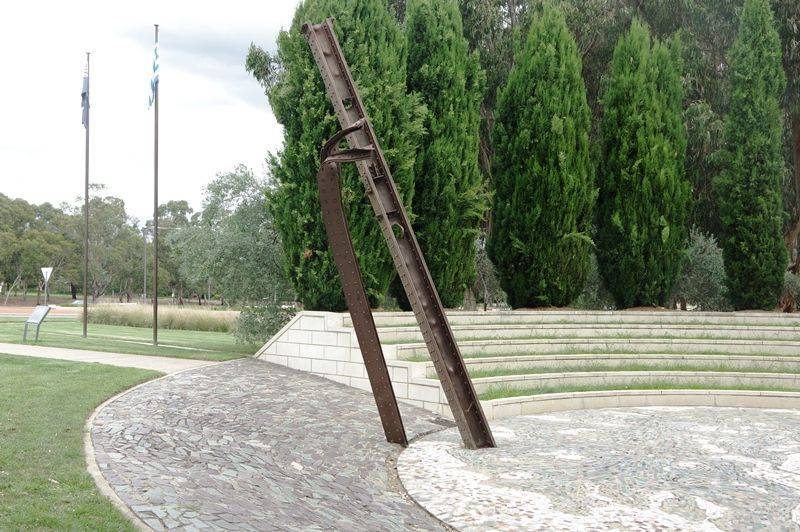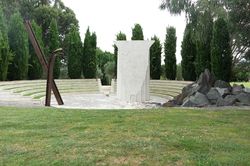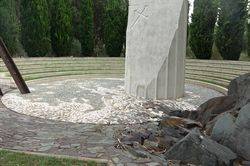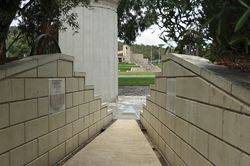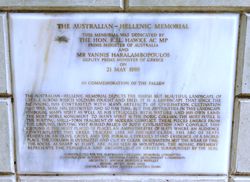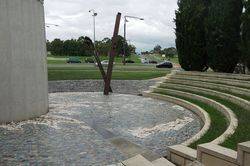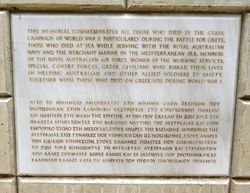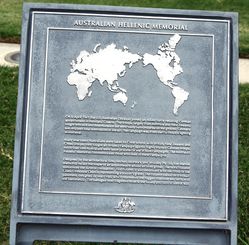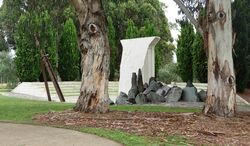
Home » Themes » Conflict » World War Two
Australian Hellenic MemorialPrint Page 
The Australian-Hellenic Memorial commemorates those who died in service or were killed in action in Greece and Crete during World War Two. The marble memorial recalls the shape of an amphitheatre amidst an olive grove. The doric column symbolises the birth of civilisation.
This column is also embossed with the cross of the Greek Orthodox Church, representing a soldier`s grave. The column stands on a mosaic pavement which represents the rugged coastline and terrain of the battlefields. The damaged steel fragment reflects the futility and destruction of war.
On 6 April 1941, the 6th Australian Division joined an Allied force resisting German advancement in mainland Greece. The campaign was, from start to finish, a fighting withdrawal. Many evacuated Australians were taken to Crete where, with British, New Zealand and Greek troops, they fought an ill-fated campaign against highly trained German troops.
More than 5000 Australians were taken prisoner of war in both campaigns.
Location
| Address: | ANZAC Parade & Limestone Avenue, Reid, 2612 |
|---|---|
| State: | ACT |
| Area: | AUS |
| GPS Coordinates: | Lat: -35.282035 Long: 149.146475 Note: GPS Coordinates are approximate. |
Details
| Monument Type: | Monument |
|---|---|
| Monument Theme: | Conflict |
| Sub-Theme: | WW2 |
| Actual Event Start Date: | 03-September-1939 |
| Actual Event End Date: | 15-August-1945 |
| Designer: | Ancher, Mortlock and Woolley Pty Ltd. |
| Artist: | Mary Hall |
| Monument Manufacturer: | John Pfeiffer Constructions |
| Link: | http://www.nationalcapital.gov.au |
Dedication
| Actual Monument Dedication Date: | Saturday 21st May, 1988 |
|---|
The Australian - Hellenic Memorial
This memorial was dedicated by the Hon. R. J. L. Hawke AC MP Prime Minister of Australia and Mr Yannis Haralambopoulos Deputy Prime Minister of Greece on 21 May 1998
In commemoration of the fallen
The Australian - Hellenic Memorial depicts the harsh but beautiful landscape of Greece across which soldiers fought and died. It is a landscape that since the beginning, has contrasted with man`s artefacts of civilisation, cultivation and war, man has destroyed and so has time. But the antiquities in this landscape symbolise man`s spirit as well as his struggles with nature and his own land.
The most noble monument to man`s spirit is the Doric column. The most futile is the rusting, shell-torn fragment of modern conflict. These pieces emerge from the ground, implying vast buried relics of both civilisation and conflict. This ground is the most placid of places, an amphitheatre of seats where an audience contemplates this Greek tragedy. Like an ancient glade, the arc of seats resides in an olive grove and the formal Cypresses stand evidence of a sacred place. The column is oversized and cut by clear imagination, not the wear of time. The rocks, as sharp as flint, are also seen as mountains, The mosaic pavement represents the peninsula and archipeligo of Greece surrounded by the seas.
Constructed for the Australian - Hellenic Memorial Committee
Construction Authority : National Capital Development Commission
Architect : Ancher Mortlock Woolley
Mosaic Artist : Mary Hall
Contractor : John Pfeiffer Constructions
Plaque :
This memorial commemorates all those who died in the Greek Campaign of World War II particularly during the Battle for Crete.
Those who died at sea while serving with the Royal Australian Navy and the Merchant Marine in the Mediterranean Sea, members of the Royal Australian Air Force, women of the Nursing Services, special covert forces, Greek civilians who risked their lives in helping Australian and other Allied soldiers so safety, together with those who died on Greek soil during World War I.


